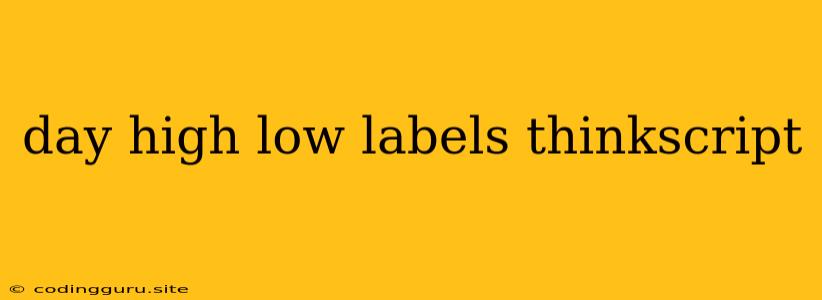Understanding Day High, Low, and Labels in ThinkScript
ThinkScript is a powerful language used for creating custom indicators and strategies in trading platforms. It allows you to analyze market data and develop your own trading logic. A crucial part of this analysis is understanding the day's high and low prices and how to effectively use them in your strategies.
What are Day High and Day Low?
The day high is the highest price a security reached during a specific trading day. Conversely, the day low represents the lowest price reached on that same day. These two values are fundamental building blocks for many technical analysis techniques and trading strategies.
How can I identify Day High and Day Low in ThinkScript?
ThinkScript provides built-in functions to retrieve the day high and day low for a specific security:
- High(Symbol, Period): Returns the highest price of the specified symbol for the current period (e.g., current day).
- Low(Symbol, Period): Returns the lowest price of the specified symbol for the current period (e.g., current day).
Example:
# Get the current day's high for the SPY ETF
spyHigh = High(SPY, Period.DAY);
# Get the current day's low for the SPY ETF
spyLow = Low(SPY, Period.DAY);
What about Labels?
Labels are a powerful tool for visualizing and annotating charts. They can be used to mark specific price points, events, or signals identified by your ThinkScript code.
Adding Labels in ThinkScript:
To add a label to your chart, you can use the AddLabel() function:
# Add a label at the current day's high
AddLabel(spyHigh, "Day High", Color.RED, LabelStyle.TOP_RIGHT);
This code will add a label at the day high price with the text "Day High", colored in red and positioned at the top right corner of the label.
How can I utilize Day High and Day Low in my ThinkScript strategies?
- Identify potential reversals: When price approaches the day high or day low, it can signal a possible change in momentum.
- Set stop-loss levels: Using the day low as a stop-loss level can help manage risk by limiting losses on a trade.
- Determine support and resistance: The day high and day low can act as potential support and resistance levels for future price action.
- Create breakout strategies: When price breaks through the day high or day low, it can signal a strong bullish or bearish move.
Example:
# Define a simple breakout strategy
if close > High(symbol, Period.DAY)
# Breakout above the day high, consider buying
else if close < Low(symbol, Period.DAY)
# Breakout below the day low, consider selling
Conclusion:
Understanding and utilizing day high and day low values within ThinkScript can greatly enhance your technical analysis and trading strategies. Using these tools effectively can lead to improved decision-making and risk management. Remember to experiment and refine your strategies as you gain more experience with ThinkScript and its capabilities.
